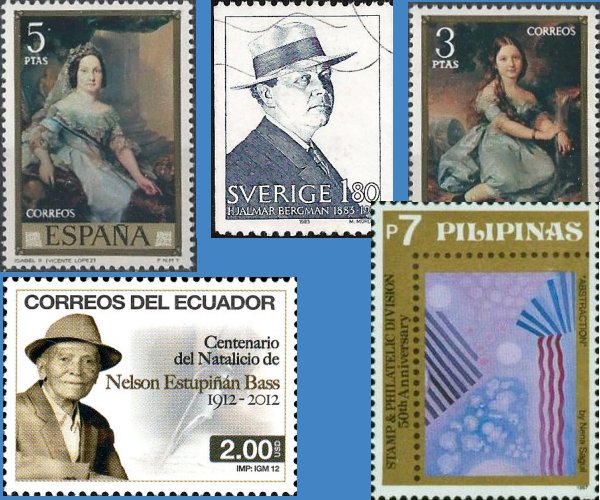The Arts on Stamps of the World — September 19
An Arts Fuse regular feature: the arts on stamps of the world.

By Doug Briscoe
Apart from a token of respect at the end, we have only four artists—two writers, two painters—gracing today’s Arts on Stamps of the World page, and I daresay you won’t know any of them. I didn’t.
Spanish portrait painter Vicente López Portaña (September 19, 1772 – July 22, 1850) began formal art studies at thirteen and won a scholarship at seventeen. He was named an honorary court painter by King Charles IV, then official court painter by Ferdinand VII, then Royal Court Painter. Although López did paint many religious, mythological, and historical canvases, the Spanish stamp set from 1973 focuses exclusively on his portraits. At upper left is King Ferdinand; at lower left his Queen Isabella II; next to Ferdinand a detail from the artist’s self-portrait. Mingled in with other court notables are López’s portrait of an elderly Goya (on the 7 pesetas denomination) and a picture of organist and composer Félix López (15 ptas, no relation).
Swedish writer Hjalmar Bergman (19 September 1883 – 1 January 1931) married into a family immersed in theater, his in-laws being actors, a producer, and a director. His own foremost production was a series of novels á la Balzac centered on several families in a small Swedish town. The intertwining stories reveal a good many skeletons in closets. Bergman’s own private skeleton, alas, was alcohol and drug addiction, and he died prematurely at age 47. With the portrait stamp is one citing his final work, the self-referential Clownen Jac (1930, Jac The Clown).

The focus of Ecuadorian writer Nelson Estupiñán Bass (1912 – 3 March 2002), meanwhile, was the mixed-race populace of his native country, viewed from a socialist perspective. He began as a poet and made an international success with his first novel, When the Guyacanes Flourished (Cuando los Guayacanes Florecían, written 1943, published 1950). It tells of the exploitation of Afro-Ecuadorian workers in an election of 1895. There followed a book of poetry, The Song of the Black Child and the Light (Canto negro por la luz, 1956) and several more volumes of fiction, poems, essays, and criticism. He happened to be on a lecturing tour in the United States when he expired at the age of 89. An extensive biography can be found here.
We also salute Filipino modern artist Nena Saguil (September 19, 1914 – February 1994). Her father was the personal physician to President Manuel L. Quezon. Rather than follow her parents’ wishes to attend a Catholic school, she opted to study at the University of the Philippines School of Fine Arts, where one of her classmates was Anita Magsaysay. Thoroughly grounded in the conservative style, she became more interested in modern art only after World War II. She tried her hand at Cubist and Surrealist canvases. I couldn’t resist offering her 1953 Power Room, which, to quote the Geringer Art article, “features a toilet-headed figure wielding a plunger and a whip in a tiled bathroom setting embellished with coils of human waste.” (Following on my comment yesterday about Anton Mauve, I may earn a reputation here as a coprophiliac if I’m not careful.) Scholarships enabled Saguil to study further in Spain and Paris, where she remained for ten years, sometimes working as a maid, before returning to Manila for an exhibition in 1968. Thereafter her work appeared in numerous shows in Europe and the United States. Again to quote the Geringer article, “Nena Saguil’s mature abstract works are often described as cosmos and many contain spheres, fibers, dots, vortices and bubbles. Her imagery has also been characterized as cellular, and some of her forms appear as if seen through a microscope. Saguil was a Jehovah’s Witness in her later decades, and her work often contains a sense of spirituality and religious feeling.” The piece on the stamp is titled simply Abstraction.
A quick tip of the hat (and bow of the head) to the late Adam West (September 19, 1928 – June 9, 2017). From a recent (2014) set of Batman stamps I chose the one that most closely approximates the era of Mr. West’s landmark TV show.
Although I’m not surprised there’s no stamp dedicated to the wonderful English illustrator Arthur Rackham (19 September 1867 – 6 September 1939), I confess I did rather hope to find his work decorating a stamp from somewhere. Guess not. Here, by the way, is his quite uncharacteristic Self-Portrait. Nothing either for Lord of the Flies author William Golding (19 September 1911 – 19 June 1993). A few British actors of note share this birthday: Rosemary Harris (born 19 September 1927), David McCallum (1933), and Jeremy Irons (1948).
A graduate of the University of Massachusetts with a B.A. in English, Doug Briscoe worked in Boston classical music radio, at WCRB, WGBH, and WBUR, for about 25 years, beginning in 1977. He has the curious distinction of having succeeded Robert J. Lurtsema twice, first as host of WGBH’s weekday morning classical music program in 1993, then as host of the weekend program when Robert J.’s health failed in 2000. Doug also wrote liner notes for several of the late Gunther Schuller’s GM Recordings releases as well as program notes for the Boston Classical Orchestra. For the past few years he’s been posting a Facebook “blog” of classical music on stamps of the world, which has now been expanded to encompass all the arts for The Arts Fuse.

